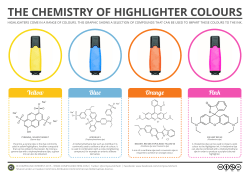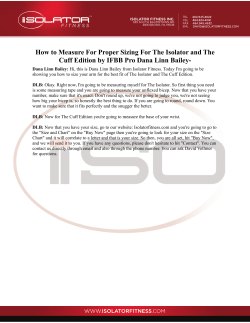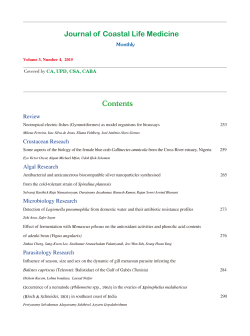
Traditional dye yielding plants of Tripura, Northeast
B I O D I V E R S IT A S Volume 16, Number 2, October 2015 Pages: 121-127 ISSN: 1412-033X E-ISSN: 2085-4722 DOI: 10.13057/biodiv/d160203 Short Communication: Traditional dye yielding plants of Tripura, Northeast India BISWAJIT SUTRADHAR1, DIPANKAR DEB2,, KOUSHIK MAJUMDAR1, B.K. DATTA1 1 Plant Taxonomy and Biodiversity Laboratory, Department of Botany, Tripura University (A Central University), Suryamaninagar 799022, Tripura, India 2 Agroforestry and Forest Ecology Laboratory, Department of Forestry and Biodiversity, Tripura University (A Central University), Suryamaninagar 799022, Tripura, India. Tel. 0381-237-9093, Fax. 0381-237-4807, e-mail: debdip23@gmail.com Manuscript received 27 October 2014. Revision accepted: 14 May 2015. Abstract. Sutradhar B, Deb D, Majumdar K, Datta BK. 2015. Traditional dye yielding plants of Tripura, Northeast India. Biodiversitas 16: 121-127. This present paper deals with the survey of traditional dye yielding plants, their ethnobotanical usage and cultural practices by the different ethnic communities of Tripura. Field investigation was carried out in different villages and adjacent forest pockets in South and West district of the State. The ethnobotanical information was collected based on semi-structured questioner, personal interviews and group discussion among the major ethnic communities of Tripura. The study reports a checklist of 39 species of dye yielding plants belonging to 35 genera and 26 families documented along with their vernacular name, habit, parts use. The active colouring agents were also listed for each plant based on earlier reports. Natural dye yielding plants have immense significance in the socio-economic and socio-cultural life of indigenous ethnic people and if we promote these products in a managed way then efforts towards preservation of traditional knowledge and local biodiversity will be more fruitfully achieved. Keywords: Dye yielding plants, indigenous knowledge, natural products, Tripura INTRODUCTION The relation between man and plants originated with the prehistoric human civilization with early human Neanderthals to modern human civilization. The plants are used not only for maintaining the basic life sustaining needs like food, fuel, shelter, but also for making clothes and natural dye to fabric clothes (Das and Mondol 2012). Natural dyes occupy an important place in human culture and dye yielding plants were probably discovered early through human curiosity, use, reuse and trials (Canon and Cannon 2003; Dogan et al. 2008). The first report of natural dye extraction from plant sources dates back to around 2600 BC in China. The Indus valley civilization at Mahenjo-Daro and Harappa (3500 BC) traces of dyeing garments with natural madder (Siva 2007). According to Dogan et al 2008, the use of natural dye stuff in by Phoenicians, Hebrews and Venetians was also started from the beginning of 13th century (Dogan et al. 2008). Later the technology passed across regions and cultures like Greeks, Romans, old world Africans, Mexicans and was also evident in Peru (TRMIC 1991; Dogan et al. 2008). According to Zohary and Hopf (1994), dye yielding plants have been cultivated in southwest Asia since ancient times and earliest persisting indication of textile dyeing comes from an over 5,000-year-old piece of cloth dyed with natural madder (Rubia cordifolia) discovered at Mohenjo-Daro (Singh 2002; Mahanta and Tiwari 2005; Das and Mondol 2012). Natural dyes are colorants derived from plants, invertebrates or minerals, while majority of natural dyes are extracted from vegetable or plant sources like roots, berries, bark, leaves, wood and other biological sources such as fungi and lichens. The use of natural dyes has been declining since the discovery of synthetic dyes (Singh 2002). However, many studies have found that synthetic dyes are harmful to human health as well as environment (Kwok et al. 1999; Singh and Singh 2002; Cristea et al. 2003; Mahanta and Tiwari 2005; Seker et al. 2006). Natural dyes are environment and skin friendly; for example, turmeric, the brightest of naturally occurring yellow dye is a powerful antiseptic and revitalizes the skin, while indigo yields a cooling sensation. Hence, there exist a significant justification for the application and promotion of natural dyes as they are harmless both for human and environment (Hartl and Vogl 2003; Kumar and Sinha 2004; Kim and Park 2007). The present study is a comprehensive account of dye yielding plants of Tripura and gathers information on traditional knowledge system of extraction and use of natural dyes by the local ethnic people. Consequently, the study is an attempt to overcome the paucity of documentation of dye plants and to create baseline information on the natural sources of plant based dye. The significant research on ethnobotany has created a mass awareness among the scientists in India during the last two decades (Rashid 2013). A number of publications have come from different regions of India including the north eastern states related to the traditional health care practices, wild edible plants, ethnoveterinary plants and fiber plants (Borthakur 1976, 1995; Tiwary et al. 1978, 1979; Bhattacharjee 1980; Barua and Sharma 1984; Mahanta 2005; Sawian et al. 2007; Jamir 2008; Kar and 122 B I O D I V E R S IT A S 16 (2): 121-127, Ocotober 2015 Borthakur 2007). In north eastern states some pioneer workers have made a brief note on dye plants (Akimpou et al. 2005; Kar and Borthakur 2007). Ethnobotanically Tripura has quiet lagged behind rest of India (Deb et al. 2012). However, few workers have made a concise note on traditional ethno medicine and wild edible plants (Deb 1968; Singh 1997; Majumdar and Datta 2007; Das 2009; Roy 2010; Sen et al. 2011, Deb et al 2012). But, none of the workers have made a detailed note of customary dye yielding plants of Tripura used by the ethnic peoples of the state and therefore this is the first such study. Materials and Methods Study area Tripura is one of the seven states in the north eastern part of India with a geographical area of 10, 491 sq Km. It is located in the south west extreme corner of the north eastern region, between 22° 57' to 24° 33' N latitude and 97° 10' to 92° 20' E longitude (Figure 1). The state is situated between river valley of Myanmar and Bangladesh on the north, west, south and southeast; in the east it has a common boundary with states of Assam and Mizoram. Tripura is a land locked state and its geographical limits touch both national and international boundary lines. International boundary with Bangladesh measures 839 km. Its national boundary with Assam and Mizoram measures 53 km and 109 km respectively. The average minimum temperature is 15°C and maximum temperature is 34°C. The average annual rain fall in the state is 2024.4 mm. Figure 1. Study site in the State of Tripura, India The major part of the State is covered by dense forests in which various ethnic groups live close to the forest and are largely dependent on the wild biological resources for their livelihood. The ethnic groups inhabiting different areas of the state have indigenous knowledge systems and have evolved methods for utilizing the vast plant resources available. Floral diversity is the main source of raw materials being used traditionally by the indigenous people of Tripura state as food supplements and for fodder, fibers, construction, handicrafts, beverages, coloring agents (dyes) and more importantly in health care practices. Their knowledge in utilizing these resources is characteristic and differs from community to community. Field survey Field investigations were conducted during the year 2013-2014 as per well planned schedule and rich pocket of tribal areas were visited for documentation of dye yielding plants. Survey was done by standard procedure (Jain and Rao 1977), through a questionnaire and group discussion with the community heads, old people, women and also village local market (Rao and Hazra 1994). The specimens were collected from the adjacent forest area with the help of local informant. The plant specimens were made into herbarium following the standard herbarium techniques. Herbarium specimens were identified with the help of Flora of Tripura State (Deb 1983). The reference specimens were deposited in the herbarium of Department of Botany, Tripura University, India. B I O D I V E R S IT A S Volume 16, Number 2, October 2015 Pages: 121-127 ISSN: 1412-033X E-ISSN: 2085-4722 DOI: 10.13057/biodiv/d160203 Table 1. Traditional dye yielding plants of Tripura, India Scientific name Family Local name Adhatoda vasica (L) Nees. Acanthaceae Basak Alpinia galanga (L) Willd. Zingiberaceae Areca catechu Linn. Arecaceae Basella alba Linn. Bauhinia variegata Linn. Bauhinia purpurea Linn. Basellaceae Fabaceae Fabaceae Bixa orellana Linn. Part used Dye colour Leaves Dye uses for Active coloring agent Yellow Cotton Telbanok juknai Root stalk sam (Kok) Supari, Gua Seed Yellowish green Red color Cotton, wool Adhatodic acid, carotein, lutolin, quercetin (Singh et al. 2011) Galangin (Chudiwal et al. 2010) Cotton Gallotannic acid (Amudhan et al. 2012) Fruit Petal Petal Violet Silk and cotton, food coloring Light pink Cotton Pink Cotton and silk Gomphrenin-I (Kumar et al. 2013) Anthocyanin (Jash et al. 2014) Chalcone, butein (Gokhle et al. 2004) Bixaceae Muifrai (Kok) Kanchan (Beng) Goondilata (Kok) Powassi Seed Wool and cotton Bixin, orellin, beta-carotene (Siva 2007) Butea monosperma (Lam.) Taub. Camellia sinensis Linn. Celosia argentea Linn. Clerodendrum philippinum Schau. Clitoria ternatea Linn. Curcuma domestica Valeton. Fabaceae Jong-obi (Kok) Petal Orange/ Red Orange Theaceae Amaranthaceae Verbenaceae Cha Sweet murga Not known Black Red color Green Orange dye, which is used for coloring the clothes and other decorative purposes Fishing net, cotton, rope Wool and cotton Silk and cotton Butein, butin, isobutrin, coreopsin, isocoreopsin (Sindhia and Bairwa 2010) Phenolic compound, flavonoids (Reto et al. 2007) Betalains pigment (Patel et al. 2010) Phenolic compound (Tiwary and Bharat 2008) Fabaceae Zingiberaceae Aparajita (Beng) Flower Haldi Rhizome Blue Yellow Anthocyanin pigment ternatin (Kazuma et al. 2003) Curcuminoids, curcumin (Revathy et al. 2011) Curcuma zedoaria Roxb. Zingiberaceae Halka Yellow Cuscuta reflexa Roxb. Diospyros peregrina Gürke. Convolvulaceae Ebenaceae Jirai (Kokborok) Whole plant Yellow Makur (Kok) Fruit Black Wool, cotton, silk Wool, silk and cotton and also a food colorant For the production of Abir powder used in Holi Silk and cotton Fishing net, cotton Duranta repens Linn. Verbenaceae Ban mehendi Eclipta prostrata Linn. Asteraceae Hibiscus rosa sinensis Linn. Malvaceae Indigofera tinctoria Linn. Fabaceae Anthocyanidins, isoflavanol, flavone (Kumar and Singh 2012) Indigotin (Saraswathi et al. 2012) Erythrina variegate Roxb. Fabaceae Leaves Flower Leaves Rhizome Curcumin, arabins and albuminoids (Hamdi et al. 2014) Leaves/ Seed Manathingsabup Leaves hang (Kok) Jaba Flower petal Nil Green crop Green/ Orange Black Cuscutin, quercetin, coumarin (Ramya et al. 2010) Triterpenes, B-sitosterol, betulin, gallic acid (Sinha and Bansal 2008) Silk, cotton and for palm staining of girls Durantosides, c-alkylated flavonoids (Ahmed et al. 2009) Hair blackening and cotton Phenols, coumarins, flavones (Lee et al. 2008) Red Wool and cotton Blue Silk, wool cotton Mandar (Beng) Red Wool and cotton Flower Anthocyanin and betalains pigment (Subhashini et al. 2011) B I O D I V E R S IT A S 16 (2): 121-127, Ocotober 2015 124 Lawsonia inermis Linn. Lythraceae Mehendi Leaves Mallotus philippensis (Lam.) Muell. Arg. Euphorbiaceae Khurchub (Kok) Seed Yellow red The dye obtained from macerated or Lawsone (Musa and Gasmelseed 2012) powdered leaves stains skin. Leaves also used for colouring skins, Leather, silk and wool.. Red Silk, cotton, wool Rottlerin, isorottlerin (Sharma and Varma 2011) Melastoma malabathricum Linn. Melia azedarach Linn. Morinda tinctoria Roxb. Melastomataceae Phutki, Ban Stem/ Seed Red/ Black Cotton and wool padam Meliaceae Ghora neem Leaves Blue Cotton Rubiaceae Haldiruk (Kok) Root Red The dye is used for coloring cotton cloth & other printing materials. Musa acuminata Colla Musaceae Thailic Pseudostem Black The sap is used for colouring traditional (Kok) attire Nyctanthes arbor-tristis Linn. Nyctanthaceae Hengra Flower tube Orange The dye is used for coloring silk; also (Kok) useful in printing purposes. Parkia javanica Merr. Fabaceae Kuki Tetai Fruit peel Brown/ Silk and cotton Black Phyllanthus emblica Linn. Phyllanthaceae Amla Bark/ fruit Black Cotton, rope, silk (Kok/ Beng) Piper betle Linn. Piperaceae Fatwi (Kok) Leaves Red brown Cotton Psidium guajava Linn. Myrtaceae Gayam Fruit Yellow red Silk and cotton Rubia cordifolia Linn. Rubiaceae Fruit Red Solanum nigram Linn. Solanaceae Strobilanthes cusia (Nees) O. Kuntze. Tectona grandis (Linn. f) Acanthaceae Manjistha (Beng) Rummunta (Halam) Not known Lamiaceae Segun Terminalia arjuna (Roxb.) White & Arn. Terminalia belerica Roxb. Combretaceae Terminalia chebula Retz. Fruit Wool, cotton and silk Cotton Arjun Brown black Leaves/ Black & young buds blue Young Red leaves Fruit Brown Combretaceae Bahera Fruit Combretaceae Bakhla (Kok) Fruit Not known Catechin, quercetin (Sen and Batra 2012) Morindone (Shanthi et al. 2012) Not known Nyctanthin, carotenoids (Sah and Verma 2012) Carotenoids, flavonoids (Chanu et al. 2012) Flavonoids,kaempferol, ellagic acid and gallic acid (Habib-ur-Rehman et al. 2007) Piperitol, piperbetol, eugenol, piperol (Pradhan et al. 2013) Guajanoic acid,carotenoids, lectins, leucocyanidin (Kamath et al. 2008) Manjistin, Purpurin (Siddiqui et al. 2011) Silk, cotton, wool Gallic acid, catechin, caffeic acid, epicatechin, rutin, and niringenin (Gogoi and Islam 2012) Lupeol, betulin, lupenone, indigo, indirubin (Li et al. 1993) Tectoleafquinone (Khera and Bhargava 2013) Wool and cotton Arjunic acid (Burapadaja and Bunchoo 1995) Black Silk and cotton Black Cotton Chebulaginic acid, gallic acid, ellagic acid (Meena et al. 2010) Chebulinic acid (Lee et al. 2008) Silk and cotton B I O D I V E R S IT A S SUTRADHAR et al. – Dye yielding plants of Tripura, India Volume 16, Number 2, October 2015 Pages: 121-127 Results and Discussion The study elucidated the 39 dye yielding plants of Tripura which were traditionally used by the tribal of Tripura. Among these plants, many were common to all communities, and their uses were also almost same. The documented natural dye yielding plants with their vernacular name, part used, dye color, specific uses and coloring agent are listed in Table 1. The listed plant species belong to 3 families of monocotyledons (12% species) and 23 families of dicotyledons (88% species). Among the monocotyledons, Zingiberaceae is represented by 3 species while Musaceae and Arecaceae are represented by single species each. Among dicotyledons, 7 species (18%) are Fabaceae; 3 species (8%) Combretaceae followed by Acanthaceae, Rubiaceae and Verbenaceae with 2 species (5%) each. Dyes were produced from different parts of the plants i.e. underground parts (root 5%, rhizome 5%), stem (4%), bark (3%), leaf (26%), flower (21%), fruit (26%), seeds (13%) or even whole plant (5%). More than 2 plant parts were used in7% species of documented plants. The important dyes extracted from roots or rhizome include Alpinia galanga (L) Willd., Curcuma domestica Valeton., Curcuma zedoaria Roxb., Morinda tinctoria Roxb. Hort. Beng. Stem and bark is the important source of the species Melastoma malabathricum Linn., Phyllanthus emblica Linn. etc. Floral dyes includes Bauhinia variegata Linn., Bauhinia purpurea Linn., Butea monosperma, Celosia argentea Linn., Clitoria ternatea Linn., Hibiscus rosa sinensis Linn., Erythrina stricta Roxb., Nyctanthes arbor-tristis Linn. etc. Commonly used fruit dyes are obtained from Basella alba Linn., Diospyros peregrina Gürke., Parkia javanica Merr., Rubia cordifolia Linn., Solanum nigram Linn., Terminalia belerica Roxb., Terminalia chebula Retz., Terminalia citrina ( Gaertn.) Roxb but in some cases tender fruits of Psidium guajava Linn. is used for black coour. The leaf dyes are extracted from Adhatoda vasica (L) Nees., Camellia sinensis Linn., Clerodendrum philippinum Schau., Duranta repens Linn., Eclipta prostrata Linn., Lawsonia inermis Linn., Melia azedarach Linn., Piper betle Linn., Strobilanthes cusia (Nees) O. Kuntze., Tectona grandis (Linn. f) etc. Whole plant is used in case of Cuscuta reflexa Roxb. Green crop of Indigofera tinctoria Linn. is used while sap of pseudostem is used for Musa acuminata Colla. Dyes extracted from the various plant parts are weak in nature and their permanency varies from plant to plant and traditional techniques of preparation. Use of multiple plants parts in a particular ratio may increase the longevity of dye. Sometimes special techniques viz. heat and cold treatment may increase dye stability. The selection of plants also depends on the colour choice, product type and purpose. This present study recorded 14 different colors from 12 different plant parts, where black colour was yielded by maximum number (26%) of plants. The ethnic communities used their own customary approach to extract and process the natural dye. Ethnic communities used the dye yielding plants for various day to day activities like colouring food and clothes, making cosmetics and fashion jeweleries. The dyes ISSN: 1412-033X 125 E-ISSN: 2085-4722 DOI: 10.13057/biodiv/d160203 are coloured compound capable of being fixed to fabrics which do not washout with soap and water or fade on exposure to light. For dyeing purposes, either fresh extract or paste form were best suited for the communities. Present record of 38 species was very high compared to 10 species reported from West Bengal (Das and Mondol 2012) and 15 species from Manipur (Akimpou 2005) and less than the documentation of 47 species from Assam (Kar and Borthakur 2008). However, documentation of 37 species from Arunachal Pradesh and 33 species from Central India (Tiwari and Bharat 2008) was quite similar to the present study. Thus, the study presents the potential resources of dye plants which have immense scope and small-scale industrial prospects. But the indigenous knowledge of processing and using the natural dyes from plants has to be valued and at the same time has to be upgraded or value added to incorporate with modern product generation. In conclusion, the indigenous knowledge of extraction, processing and practice of using natural dyes has declined to a great extent among the new generation due to easy availability of cheap synthetic dyes and modern attitude and life style. It has been observed that the traditional knowledge of dye making is now practiced by older people only. Unfortunately, there is lack of fruitful attempts to promote and conserve this immense treasure of traditional knowledge. Typically, most commercial synthetic dyes are attractive in color and are easy and cheap to processes. But, material collection for preparation of natural dye is closely dependent on resource availability, seasons and proper traditional knowledge. Due to lack of precise technical knowledge on the extraction and dyeing procedure, the natural dyes could not compete with commercially successful synthetic dyes. The natural dyes obtained from plant sources are biodegradable and non-toxic. Indigenous traditional knowledge on dye yielding plants is very essential for community based development, future bio prospecting and eco-friendly products. ACKNOWLEDGEMENTS The authors are grateful to Department of Biotechnology, Government of India for the financial assistance received through Bioresource network Project (No. BT/29/NE/2011). They also indebted to Mantosh Roy and Partha Das for field assistance. Special thanks are due to all the ethnic informants of different communities for their active participation and knowledge sharing during the field investigations. REFERENCES Ahmed WS, Mohamed MA, El-Did RA, Hamed MM. 2009. New triterpene saponins from Duranta repens L. and their cytotoxic activity. Molecules 14:1952-1965. Akimpou G, Rongmei K , Yadhava PS. 2005. Traditional dye yeilding plants of Manipur. Indian J Tradit Know 4 (1): 33-38. Alawa KS, Ray S and Dubey A. 2013. Dye yielding plants used by tribals of Dhar district, Madhya Pradesh, India. Sci Res Rep 3: 30-32. 126 B I O D I V E R S IT A S 16 (2): 121-127, Ocotober 2015 Amudhan MS, Begum VH, Hebber KB. 2012. A review on phytochemical and pharmacological potential of Areca catechu L. seed. IJPSR 3: 4151-4157. Baruah P, Sharma GC. 1984. Studies of the medicinal uses of plants by Boro tribe of Assam. J Eco Tax Bot 8: 599-604. Bhattacharjee S, Tiwari KC, Majumder R, Misra AK. 1980. Folklore medicine from district Kamrup (Assam). Bull Medico-Ethnobot. Res1:447-460. Borthakur SK. 1976. Less known medicinal uses of plants among tribals of Mikir hills. Bull Bot Surv India 18: 166-171. Burapadaja S, Bunchoo A. 1995. Antimicrobial activity of tannins from Terminalia citrina. Planta Medica 61: 365-6. Cannon J, Cannon M. 2003. Dye Plants and Dyeing. Timber press in association with the Royal Botanic Gardens, Kew. Chanu KV, Ali M. Ayub and Kataria Meena. 2012. Antioxidant activities of two medicinal vegetables: Parkia javanica and Phlogacanthus thyrsiflorus. Int J Pharm Pharm Sci 4: 102-106. Chudiwal AK, Jain DP, Somani RS. 2010. Alpinia galanga Willd. an overview on phyto-pharmacological properties. Indian J Nat Prod Resour 1: 143-149. Cristea D, Bareau I, Vilarem G. 2003. Identification and quantitative HPLC analysis of the main flavonoids present in weld (Reseda luteola L.). Dyes Pigments 57: 267-272. Das HB, Majumdar K, Datta BK, Ray D. 2009. Ethnobotanical uses of some plants by Tripuri and Reang tribes of Tripura. Nat Prod Rad 8 (2): 172-180. Das PK, Mondal AK. 2012. The dye yielding plants used in traditional art of Patchitra in pingla and mat crafts in Sabang with prospecting proper medicinal value in the Paschim Medinipur District, West Bengal, India Int J Life Sci Bio Pharm 1: 158-171. Deb DB. 1968. Medicinal plants of Tripura State. Indian For 94 (10): 753765. Deb DB. 1983. The Flora of Tripura State. Today & Tomorrows Printers & Publishers. Deb D, Darlong L, Sarkar A, Roy M, Datta BK. 2012. Traditional ethnomedicinal plants use by the Darlong tribes in Tripura, Northeast India. Int J Ayurved Herb Med 2 (6): 954-966. Devi Meena VN, Ariharan VN and Nagendra PP. 2013. Annato: ecofriendly and potential source for natural dye. Int Res J Pharm 4: 106108. Dogan Y, Baslar S, Ozturk M and Mert HH. 2008. Plants used as dye sources. (eds. Peter KV) Underutilized and Underexploited Horticultural Crops 3:109-145. Gogoi P, Islam M. 2012. Phytochemical screening of Solanum nigrum L and S. myriacanthus Dunal from Districts of Upper Assam, India. OSR J Pharm 2: 55-459. Gokhle SB, Tatiya AU, Bakliwal SR, Fursule RA. 2004. Natural dye yielding plants in India. Nat Prod Rad 3 (4): 228-234. Habib-ur-Rehman, Yasin KA, Choudhury MA, Khaliq Naeelam, Atta-urRahaman, Choudhury MI, Malik Sahid. 2007. "Studies on the chemical constituents of Phyllanthus emblica. Nat Prod Res. 21: 77581. Hamdi OAA, Rahaman SNSA, Awang K, Wahab NA, Looi CY, Thomas NF, Malek SNA. 2014. Cytotoxic Constituents from the Rhizomes of Curcuma zedoaria, The Scientific World J 2014 doi. 10.1155/2014/321943 Hartl A, Vogl CR. 2003. The potential use of organically grown dye plants in the organic textile industry: Experiences and results on cultivation and yields of dyers Chamomile (Anthemis tinctoria L.), dyers Knotweed (Polygonum tinctorium Ait.), and Weld (Reseda luteola L.). J Sustainable Agric 23: 17-40. Jamir, NS, Jungdan, Deb MS. 2008. Traditional knowledge of medicinal plants used by the Yimchunger Naga tribes in Nagaland. Pleione 2 (2): 223-228. Jain SK, Rao RR. 1977. A handbook of field and herbarium methods. Today & Tomorrows Printers & Publishers. Jash SK, Roy R, Gorai D. 2014. Bioactive constituents from Bauhinia variegata Linn. Int J Pharm Biomed Res 5: 51-54. Kamath JV, Nair R, Kumar Ashok CK, Lakshmi SM. 2008. Psidium guajava L: a review. Int J Green Pharm 2: 9-12. Kar A, Borthakur SK. 2007. Dye yielding plants of Assam for dyeing handloom textile products. Indian J Tradit Know 7: 166-171. Kazuma K, Noda N, Suziki M. 2003. Flavonoid composition related to petal color in different lines of Clitoria ternatea. Phytochemistry 64: 1133-1139. Khera N, Bhargava S. 2013. Phytochemical and pharmacological Evaluation of Tectona grandis Linn. Int J Pharm Pharm Sci 5: 923927. Kim H, Park S. 2007. Effects of introduced chemical groups on the dye ability of cotton fabrics with Phellodendron amurense Rupr. Dyes and Pigments 75: 351-355. Kumar A, Singh A. 2012. Review on Hibiscus rosa sinensis, Int J Res Pharm Bio Sci 3: 534-538. Kumar JK, Sinha AK. 2004. Resurgence of natural colourants: A holistic view. Nat Prod Let 18: 59-84. Kumar S, Prasad AK, Iyer SV, Vaidya SK. 2013. Systematic pharmacognostical, phytochemical and pharmacological review on an ethno medicinal plant Basella alba L. J Pharm Phyt 5: 53-58. Kwok WY, Xin JH, Chong TF. 1999. Environmental compliance for Hong Kong textile dyeing industry. Res J Tex App 3: 9-15. Lee HS, Jung SH, Yun BS, Lee KW. 2006. Isolation of chebulic acid from Terminalia chebula Retz. and its antioxidant effect in isolated rat hepatocytes. Arc Toxicol 81: 211-218. Lee MK, Ha NR, Yang H. 2008. Antiproliferative activity of triterpenoids from Eclipta prostrata on hepatic stellate cells. Phytomed 15: 775-80. Li L, Liang HQ, Liao SX, Qiao CZ, Yang JG, Dong TY. 1993. Chemical studies of Strobilanthes cusia. Acta Pharm Cinica 8 (3): 238-240. Majumdar K, Datta BK. 2007. A study on ethno-medicinal usage of plants among the Tripuri tribes of Tripura state, India. Nat Prod Rad 6 (1): 66-73. Mahanta D, Tiwari SC. 2005. Natural dye-yielding plants and indigenous knowledge on dye preparation in Arunachal Pradesh, northeast India. Cur Sci 88: 1474-1480. Meena AK, Yadav A, Singh U, Singh B, Sandeep, Kiran, Rao MM. 2010. Evaluation of physicochemical parameters on the fruit of Terminalia bellirica Roxb. Int J Pharm Pharm Sci 2: 97-99. Musa AE, Gasmelseed GA. 2012. Characterization of Lawsonia inermis (Henna) as vegetable tanning material. J For Prod Ind 1: 35-40. Ozturk M, Uysal I, Gucel S, Altundag E, Dogan Y, Balsar S. 2013. Medicinal uses of natural dye-yielding plants in Turkey. RJTA 17: 69-80. Patel BA, Patel PU, Patel RK. 2010. Physicochemical and phytochemical investigations of seeds of Celosia argentea Linn. Int J Pharm App Sci 1: 124-126. Pradhan D, Suri KA, Pradhan DK, Biswasroy P. 2013. Golden Heart of the Nature: Piper betle L. J Pharm Phyt 1: 147-167. Ramya B, Natarajan E, Vijikumar S, John vasanth J, Muthukkumarasamy S, Muthuramsanjivi VKA. 2010. Isolation and characterization of bioactive metabolites in Cuscuta reflexa Roxb. Ind J Nat Sci 1: 134139. Rao RR, Hajra PK. 1994. Methods of Research in Ethnobotany: A Manual of Ethnobotany. Scientific Publishers (India), Jodhpur. Rashid A. 2013. Dye yielding plant diversity of district Rajouri Jammu and Kashmir state-India. Int J Pharm Bio Sci 4 (1): 263 – 266. Reto M, Figueira, Fillip HM, Almelda CMM. 2007. Chemical composition of green tea (Camellia sinensis) infusions commercialized in Portugal. Plant Foods Hum Nutr 62: 139-44. Revathy S, Elumalal S, Benny M, Antony B. 2011. Isolation, Purification and identification of Curcuminoids from Turmeric (Curcuma longa L.) by Column Chromatography. J Exp Sci 2: 21-25. Roy M, Chakma B, Datta BK, Gupta AK. 2010. Traditional knowledge of medicinal plants used by Chakma tribal community of Tripura, India. Pleione 4 (1): 105-112. Sah AK, Verma VK. 2012. Phytochemicals and pharmacological potential of Nyctanthes arbor-tristis : A comprehensive review. Int J Res Pharm Biomed Sci 3: 420-427. Saraswathi MN, Kartikeyan M, Rajasekar S, Gopal V. 2012. Indigofera tinctoria Linn a phytopharmacological review, Int J Res Pharm Biomed Sci 3: 164-169. Sawian JT, Solomonnadar J, Febreena GL, Mishra BP, Laloo RC.2007. Wild edible plants of Meghalaya, North-east India. Nat Prod Rad 6: 410-26. Seker S, Ileri R, Ozturk M. 2006. Evaluation of activated sludge by white rot fungi for decolorization of textile wastewaters. J World Association Soil Water Conserv 1: 81-87. Sen S, Chakraborty R, De B, Devanna N. 2011. An ethnobotanical survey of medicinal plants used by ethnic people in West and South district of Tripura, India. J For Res 22: 417-426. Sen A, Batra A. 2012. Chemical composition of methanol extract of the leaves of Melia azedarach L. Asian J Pharm Clin Res 5: 42-45. SUTRADHAR et al. – Dye yielding plants of Tripura, India Shanthi G, Saridha D, Mariappan V. 2012. Pharmacognostical studies on Morinda tinctoria Roxb. Int J Pharm Pharm Sci 4: 636-638. Sharma J, Varma R. 2011. A Review on endangered plant of Mallotus philippensis (Lam.) M.Arg., Pharmacolog 3: 1256-1265. Siddiqui A, Tajuddin, Amin KMY, Zuberi RH, Jamal A. 2011. Standardization of Majith (Rubia cordifolia Linn.). Indian J Trad Know 10: 330-333. Sindhia VR, Bairwa R. 2010. Plant review: Butea monosperma. Int J Pharm Clinical Res 2: 90-94. Singh HB, Hynniewta TM, Bora PJ. 1997. Ethno-Medico-Botanical studies in Tripura, India. Ethnobot 9: 56-58. Singh V, Singh RV. 2002. Healthy hues. Down to Earth 11: 25-31. Singh PT, Singh M, Singh OB. 2011. Adhatoda vasica Nees: Phytochemical and pharmacological profile, The Nat Prod J 1:29-39. Sinha BN, Bansal SK. 2008. Phytochemicals from genus Diospyros (L.) and their biological activities. Ethnobot Leaflets 12: 231-244. Siva R. 2007. Status of natural dyes and dye-yielding plants in India. Curr Sci 92: 916-925. 127 Subhashini N, Purnima S, Devi JAA, Tirupati AT, Lavanya N. AntiInflammatory activity of Erythrina stricta Roxb. in albino rats. Int J PharmTech Res 3: 1014-1018. Tiwari KC, Mazumder R, Bhattacharjee S. 1978. Some medicinal plants from district Tirap of Arunachal Pradesh. Ind J Pharm Sci 40: 206208. Tiwary SC, Bharat Ajay. 2008. Natural dye-yeilding plants and indigenous knowledge of dye preparation in AchanakmarAmarkantak Biosphere Reserve, Central India. Nat Prod Rad 7 (1): 82-87. Turkish Republic Ministry of Industry and Commerce. 1991. Dyeing of woollen yarns with dyes obtained from plants. Ankara, Turkey. Venkatanarasimman B, Rajeswari T, Padmapriya B. 2012. Antibacterial potential of crude leaf extract of Clerodendrum philippinum Schauer. Int J Pharm Biol Arch 3:307-310. Zohary D, Hopf M. 1994. Domestication of Plants in the Old World, Clarendon Press, Oxford.
© Copyright 2025









